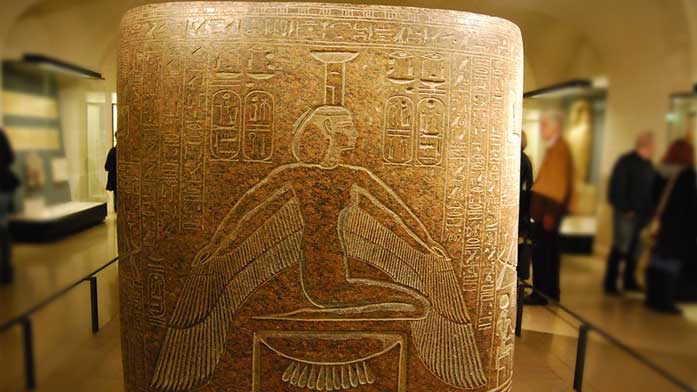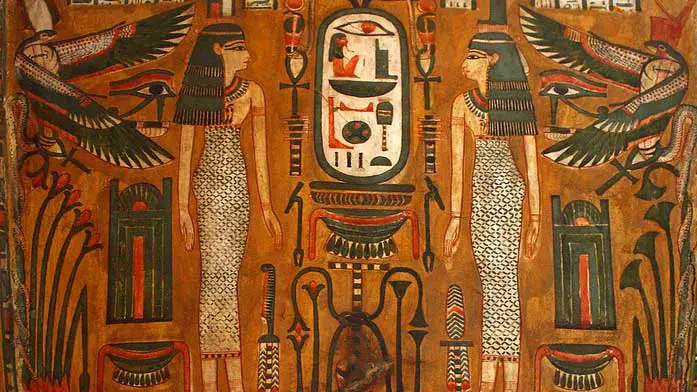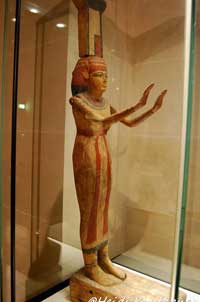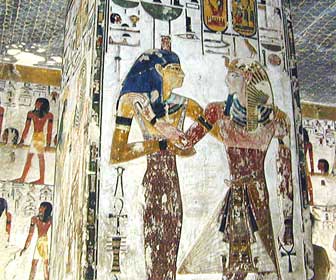Nephthys: Death Goddess, Protector, and Sister
Nephthys (called Nebet-Het in ancient Egyptian) was associated primarily with death, night, and mourning. She was a member of the Great Ennead of Heliopolis. She was primarily considered a temple deity and was most closely linked with temples dedicated to Seth or to Osiris and Isis.

© Heidi Kontkanen Nephthys
detail from sacrophagus of Ramses III
Nephthys Name and Origins
Her name meant either "mistress of the house" or "lady of the temple enclosure." She was the daughter and fourth child of Nut, goddess of the sky, and Geb, the god of the earth. Her siblings were Osiris, Isis, Set, and Horus the Elder.
Nephthys was worshipped from the earliest pre-dynastic period (before 3150 BC) through the Ptolemaic dynasty (ending in 30 BC). Some other epithets used for her were "the helpful goddess" and "the excellent goddess." Much of why she was helpful or excellent seems to be lost to history. While it is known she was held in high regard from the Middle Kingdom onward, and that she was especially important in the Heliopolitan tradition as a member of the Great Ennead, many of her myths are now lost.
Attributes of Nephthys
As the sister of Isis, Nephthys served as a sort of polar opposite. Where Isis represented birth, Nephthys represented death. However, Nephthys was also considered a protector of children and childbirth. A goddess of contradictions, she also represented healing and magic, though her major functions centered around the death state, mourning, and funerary rites.
In the Old Kingdom period especially she was considered a protector of the monarch. It may be best to understand Nephthys as a balancing element -- balance with the chaos of Seth and the purely death-focused Osiris, as well as an opposite of her sister, Isis. In this role, she is seen specifically as the goddess of mummy wrappings.

© Frans Vandewalle - Nephthys and Isis
flanking the name of Osiris
Nephthys was considered a protector of the dead as they journeyed through the afterlife. She was so effective in this role that she was given the epithet "friend of the dead." She was capable of carrying the deads' messages back to their living relatives, thus helping them through the mourning process.
Associations - Family
While Nephthys was generally considered the wife of Seth, her main allegiances were to Isis and Osiris. She was often depicted helping Isis care for the body of Osiris prior to his resurrection.
Her other chief association was with Anubis, the god of embalming. Part of this was due to the fact that she was also a funerary deity. Other myths, however, depict her as Anubis' mother or wife.
Her place among the nine Great Ennead gods underscored her importance and gave her a place in the creation and function of the universe.

© Heidi Kontkanen
Wooden statue of Nephthys
Depictions
Nephthys was usually depicted in one of three ways. In her chief form, she is a woman in a tight fitting gown, with a staff in one hand and an ankh in the other. On her head are the hieroglyphs that display her name -- a house or the front of a temple entrance.
In some other depictions, she took the form of a bird called a kite. And in still other depictions, she was shown as a woman with the wings of a kite or hawk, much like her sister Isis, with her arms stretched out protectively.
Important Myths
In one particularly important myth, Nephthys longed for Osiris and snuck to his marriage bed one night. Mistaking her for Isis, Osiris coupled with her, and Anubis was born of this union. Whether she was the mother, aunt, or wife of Anubis is ultimately unclear; she is depicted differently in each region and period of Egyptian history. In another version of this myth, Nephthys seduced Osiris by getting him drunk on wine, and thus Anubis came into being.
Nephthys once dressed as Isis in order to seduce Osiris. She was successful, prompting Seth to kill and dismember his brother in anger. Nephthys was also known to have helped Isis care for Osiris' body upon his death. Nephthys in particular was known to have wrapped each piece of Osiris' dismembered body in linen strips. This in part allowed Osiris to be resurrected later.
Nephthys is also known to have worked closely with Seth, especially in his battles with the primordial serpent, Apophis. She and Seth defended Ra's solar barque (the boat that carries the sun across the sky) against Apophis, eventually defeating him.
The Worship of Nephthys

© Jean-Pierre Dalbéra
Nephthys and Sethi I
Prayers to Nephthys occurred daily at twilight. These prayers were meant to provide protection of the vulnerable against death. Her name was also invoked in nearly all funeral rites throughout Egypt.
Within the cult of Osiris, there was an extensive prayer known as The Lamentation of Isis and Nephthys. This prayer was recited twice a day by two virgins and made up a large part of the festival celebrating Osiris' resurrection.
Prayers were offered to Nephthys to dispel demons. Though she apparently had no cult of her own, she was an integral part of the cults that surrounded the Great Ennead, and temples to her could be found in nearly every Egyptian city.
Biblography
- The gods of ancient Egypt.
- A dictionary of Egyptian gods and goddesses
